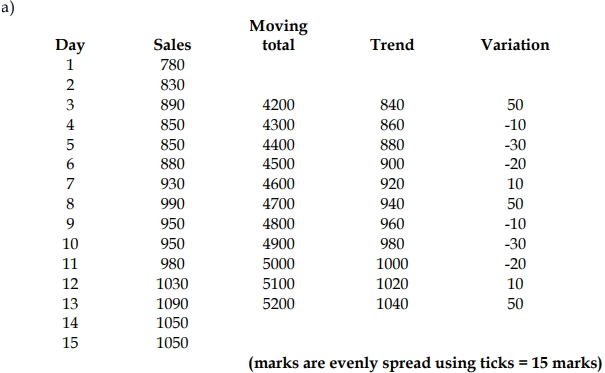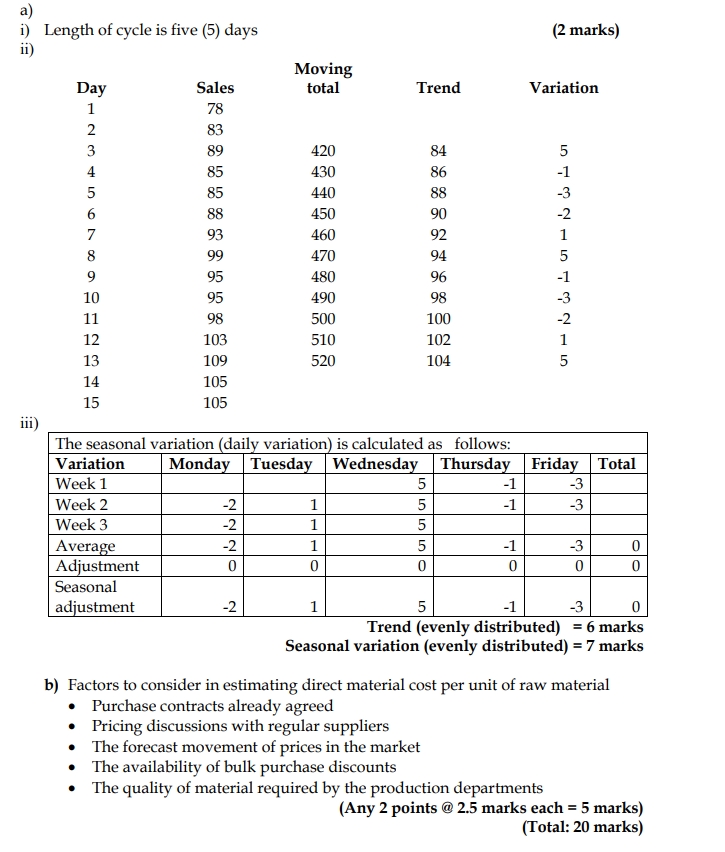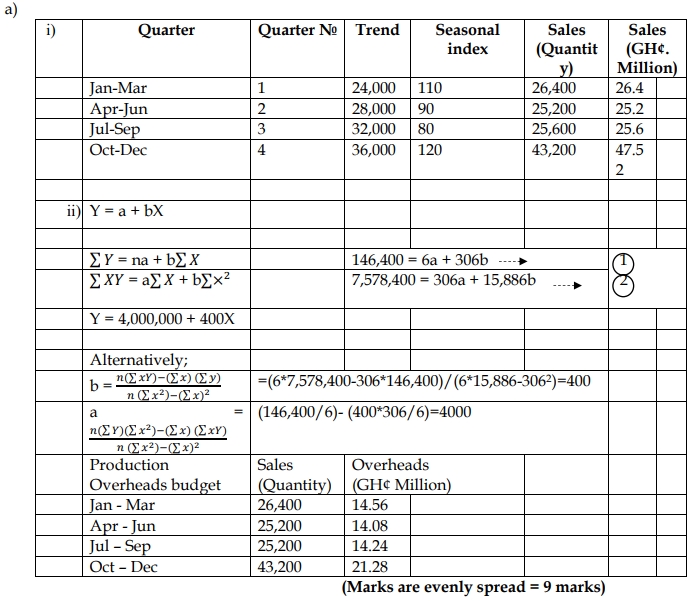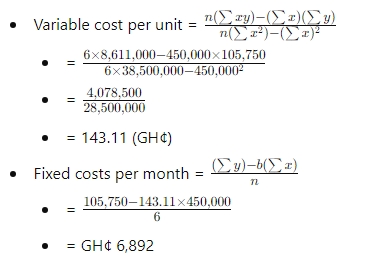- 10 Marks
Question
b) Emefa Ltd (Emefa) is in the process of preparing its budget for the month of October 2019 for its product, YEK. The Company expects to sell the product for GH¢75 but this price is expected to increase in the last quarter of 2019 by 5%. The following are the expected sales in units for the last six months in 2019.
| Month | Units |
|---|---|
| August | 7,000 |
| September | 8,000 |
| October | 9,000 |
In October 2019, a total of 9,150 units of product YEK are expected to be produced to meet demand.
Typically, cash sales represent 20% of sales. Credit sales terms are 2/10, n/30. Emefa bills customers on the first day of the month following the month of sale. Experience has shown that 60% of the billings will be collected within the discount period, 25% by the end of the month after sales, 10% by the end of the second month after the sale, and 5% will ultimately be uncollectible. The firm writes off uncollectible accounts after 12 months.
The firm uses two materials for production, Mat and Pat. The purchase terms for materials are 2/15, n/60. Experience has shown that 80% of the purchases are paid in the month of the purchase and the remainder is paid in the month immediately following. In September 2019, the firm budgeted purchases were GH¢32,000 for Mat and GH¢20,000 for Pat.
The firm’s budgeted direct material and labour budgets are as follows:
Direct Materials Purchases Budget (in Cedis) For October 2019
| Material | Budgeted Purchases (Pounds) | Expected Purchase Price per Unit (GH¢) | Total (GH¢) |
|---|---|---|---|
| Mat | 45,000 | 2.00 | 90,000 |
| Pat | 25,000 | 3.00 | 75,000 |
| Total Budgeted Purchases | 165,000 |
The production process requires direct labour at two skill levels (SL). The rate for labour at the SL1 level is GH¢45 per hour and for the SL2 level is GH¢25 per hour. The SL1 level can process one batch of YEK per hour while SL2 uses two (2) hours for the same output. Each batch consists of ten (10) units. The manufacturing of YEK also requires one-fifth of an hour of SL2 workers’ time for each unit manufactured.
Variable manufacturing overhead is GH¢100 per batch plus GH¢75 per direct labour-hour. In addition to variable overhead, the firm has a monthly fixed factory overhead of GH¢60,000, of which GH¢18,000 is depreciation expense. The firm pays all manufacturing labour and factory overhead when incurred.
Total budgeted marketing, distribution, customer service, and administrative costs for the 2019 annual budget are GH¢3,000,000. Of this amount, GH¢2,000,000 is considered fixed and includes depreciation expense of GH¢400,000. All marketing and administrative costs are paid in the month incurred.
Management desires to maintain an end-of-month minimum cash balance of GH¢100,000. The firm has an agreement with a local bank to borrow its short-term needs in multiples of GH¢10,000 up to GH¢1,000,000 at an annual interest rate of 26%. Borrowings are assumed to occur at the end of the month. Bank borrowing at October 1 was GH¢0.
Required:
Prepare the cash budget for October 2019 for Emefa Ltd. (10 marks)
Answer
Cash Budget for October 2019
| Description | GH¢ | GH¢ |
|---|---|---|
| Cash balance, beginning (given) | 100,000 | |
| Cash flow from operations: | ||
| October cash sales (9,000 x GH¢75 x 1.05) x 20% | 141,750 | |
| Collections of receivables from credit sales in September: | ||
| Within the discount period (8,000 x GH¢75) x 80% x 60% x 98% | 282,240 | |
| After the discount period (8,000 x GH¢75) x 80% x 25% | 120,000 | |
| Collections of receivables from credit sales in August (7,000 x GH¢75) x 80% x 10% | 42,000 | |
| Total collections | 585,990 | 685,990 |
| Cash disbursement | ||
| Materials purchases: | ||
| September purchases (32,000 + 20,000) x 20% | 10,400 | |
| October purchases (GH¢165,000 x 80% x 98%) | 129,360 | 139,760 |
| Direct manufacturing labour ((915 x 45) + (915 x 2 x 25)) | 86,925 | |
| Variable factory overhead (GH¢100 x 915) + (GH¢75 x 2,745) | 297,375 | |
| Fixed factory overhead (GH¢60,000 – GH¢18,000) | 42,000 | |
| Variable marketing, customer services, and Admin expenses (GH¢1,000,000/12) | 83,333 | |
| Fixed marketing, customer services, and administrative expenses (GH¢2,000,000 – GH¢400,000) / 12 | 133,333 | 782,726 |
| Cash balance, October 2019 | (96,736) | |
| New borrowing End of the month | 200,000 |
Note: The total labour cost could be (86,925 + 91,500). 91,500 is one-fifth of level 2 labour hours for each unit produced (0.4 × 9150 × 25).
(10 marks evenly spread = 10 marks)
- Tags: Cash Budgeting, Cash Flow Management, Payables, Receivables, Sales Forecasting
- Level: Level 2
- Topic: Cash Budgets and Master Budgets
- Series: MAY 2020
- Uploader: Dotse




